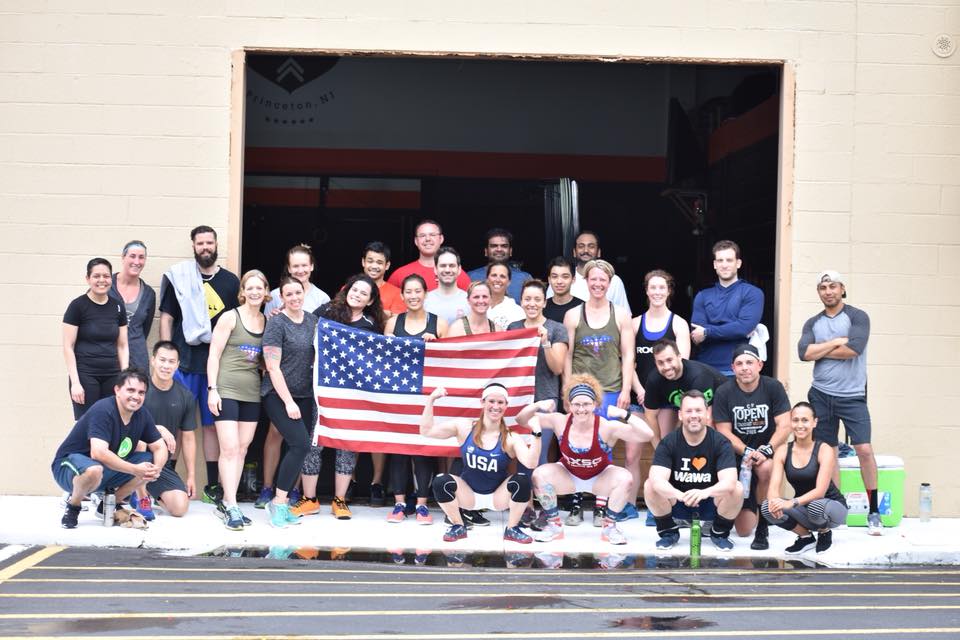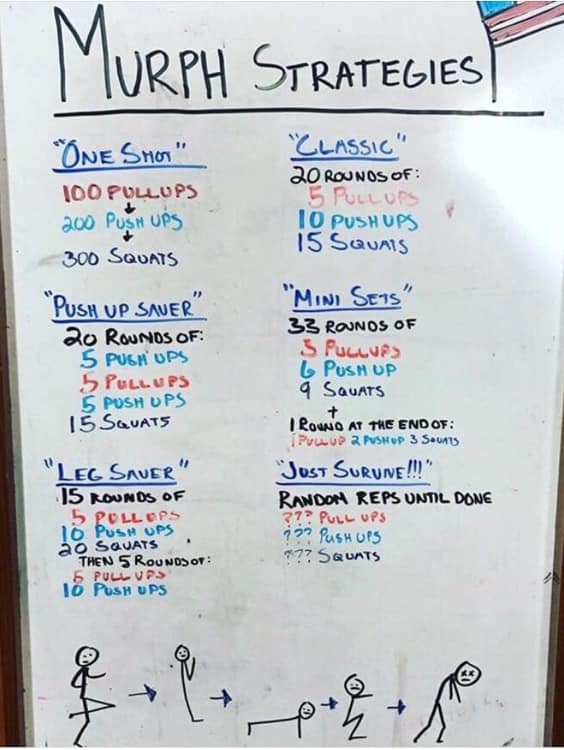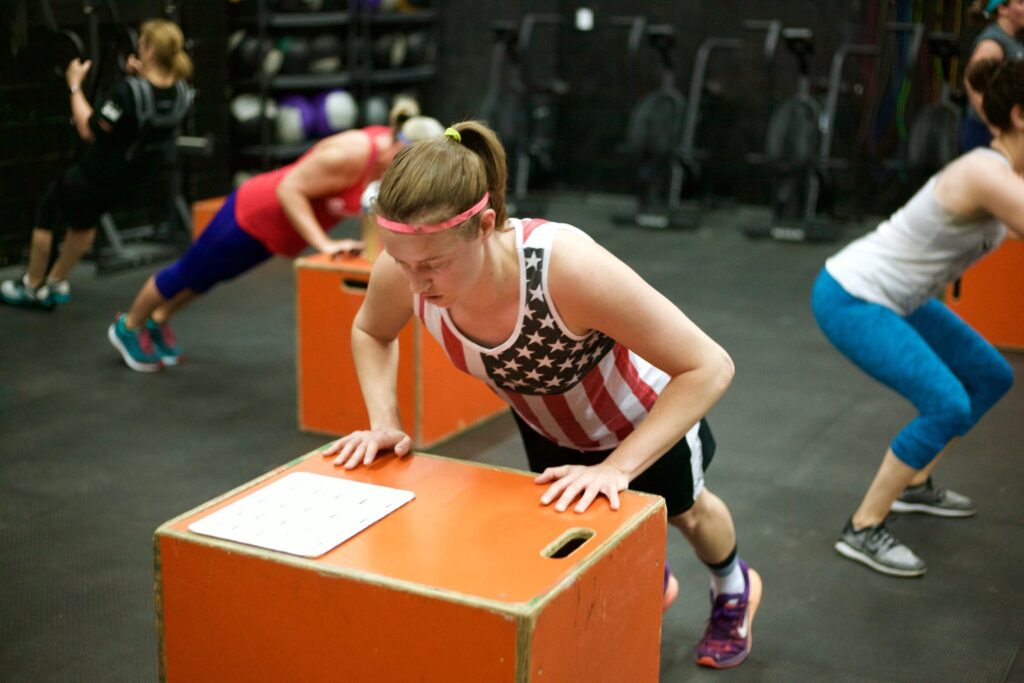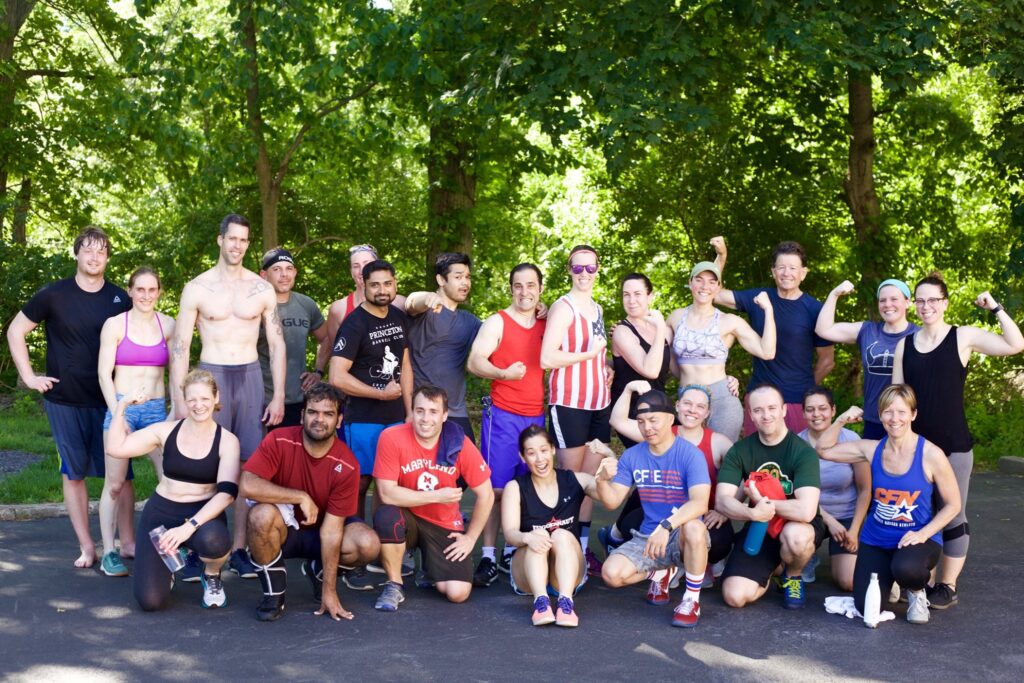Meet ‘Murph’
Memorial Day is coming up, and Crossfit gyms across the U.S. and even around the world are gearing up for a special workout: Murph.

What is Murph and why do we do it on Memorial Day?
Murph is, for time:
1 mile run
100 pull-ups
200 push-ups
300 air squats
1 mile run
If this is your first year doing CrossFit, you’re in for a treat. While most workouts fall in the 5-15 minute range and rarely exceed 30 minutes, Murph can take upwards of an hour to complete. What’s more, if you’re up for the challenge of going “Rx”, you do the whole thing wearing a 14- or 20-pound weight vest.
And whether it’s your first year doing CrossFit or your tenth, don’t worry: there are plenty of ways to modify the workout to make it accessible for anyone who wants to participate. More on that later.
First, let’s meet our hero.
The workout was named in memory of Navy Lieutenant Michael P. Murphy, who was killed in Afghanistan on June 28, 2005, when the four-man SEAL team he was leading found itself outnumbered by enemy forces, and he moved away from protective cover in order to alert the base to their situation. His actions allowed for the recovery of the bodies of his two teammates who were also killed and for the eventual rescue of the fourth.
Murphy grew up on Long Island, graduated from Penn State University, and was the first member of the Navy to win the Medal of Honor, the U.S. military’s highest decoration, since the Vietnam War.
“This workout was one of Mike’s favorites and he’d named it ‘Body Armor,’” reads the note that accompanied the workout when it was first posted on Crossfit.com that August. “From here on it will be referred to as ‘Murph’ in honor of the focused warrior and great American who wanted nothing more in life than to serve this great country and the beautiful people who make it what it is.”
In the years since it has become a tradition for Crossfitters and military members — among whom there is significant overlap — to complete the workout every year on Memorial Day and participate in The Murph Challenge, raising money for the scholarship foundation created in Murphy’s honor.
CrossFit Nassau proudly shares in the Memorial Day Murph tradition.
Murph Is Not the Only Hero
Because ties between CrossFit and the military run deep, “Murph” is not the only workout that has been created in honor of a fallen service member. CrossFit has published dozens of “hero WODs,” named for people who have been killed in the line of duty in the military or as a firefighter or police officer. These workouts tend to be longer and more challenging than the WODs you see in class day to day, and many feature heavy weights or high-skill movements.
There’s a significance to all of this: typically the numbers in the workout — the length of an AMRAP, the number of rounds, the reps for each movement — correspond to the hero’s birthday or the day they were killed. Often the movements are the ones they most enjoyed doing in their own workouts.
And while many of them are too long or complex for a class setting, they do show up from time to time. CFN’s Friday night “Carlos WOD,” for example, is usually a hero workout, capped at 45 to 60 minutes of total work.
And some of them do work well in the class setting. “DT,” for example, is pretty quick — under 15 minutes for most people, and under 5 for world class athletes — and tends to be a crowd pleaser since it’s all about the barbell. Named in honor of Air Force Staff Sergeant Timothy P. Davis, 28, by an IED during Operation Enduring Freedom in 2009, “DT” is:
5 rounds for time:
12 deadlifts
9 hang power cleans
6 push jerks
with a recommended weight of 155 pounds for men and 105 pounds for women.
The very first hero WOD ever created is also one that occasionally comes up in class. “J.T.,” named for Navy Petty Officer 1st Class Jeff Taylor, who was killed in Afghanistan June 2005 at the age of 30, is a short but brutal combination of interfering pressing movements that was first introduced on July 6, 2005.
The workout is, for time, 21-15-9 reps of:
Handstand push-ups
Ring dips
Push-ups
In the past, we took on “Nate,” a 20-minute AMRAP of 2 ring muscle-ups, 4 handstand push-ups, and 8 American kettlebell swings with 32 or 24 kilos. “Nate” was named for Chief Petty Officer Nate Hardy, who was killed in Iraq on February 4, 2008 — the inspiration for the workout’s 2-4-8 rep scheme.
The next time you take on a hero WOD, remember why you’re doing it and put in that extra bit of effort. These are the workouts where it can be appropriate to push past your comfort zone, go for the heavier weight, and struggle through higher-skill movements as long as you continue to move safely. You can learn more about the spirit behind hero WODs and their impact on the CrossFit community in this CrossFit Journal article.
Modify ‘Murph’
Back to today’s focus: Murph. While it may look intimidating on paper, like any CrossFit workout it can be adapted to any level of fitness. Beyond modifying the movements themselves, there are two main ways to go about scaling Murph: limit the total time you spend working or limit the total amount of work you do.
As a reminder, the workout is, for time:
1 mile run
100 pull-ups
200 push-ups
300 air squats
1 mile run
Wearing a 20/14 weight vest
First, let’s break down the four movements in the workout and how they can be adjusted.

Running: Barring an injury, most people can complete this part of the workout as written. If 1 mile is a long distance for you to run at once, you can make a plan to intersperse walking breaks, for example by running 200 meters then walking 100 meters. You can also use one of the modifications below that reduces the total distance or breaks it into more manageable chunks.
If a knee or ankle issue means that running is not a good option for you, the Echo bike is a good substitution. Complete 50 to 100 calories per mile depending on how proficient you are on the bike, or simply bike for 8-10 minutes at the beginning and end of the workout.
Pull-ups: 100 pull-ups is a lot of volume, so even if you can do some kipping pull-ups, it’s smart to have a back-up plan if you start struggling to get your chin over the bar or your hands are at risk of tearing.
Murph is not the time to worry about bands or jumping pull-ups; if pull-ups are not an option, ring rows are the best bet for this workout. Remember that ring rows are adjustable: the further in front of the rings you place your feet, the more challenging the movement becomes.
Push-ups: Many, many Crossfitters struggle with push-ups, and even more so when the workout calls for 200 of them. And like the pull-ups, you may want to have a plan B even if you intend to start the workout by doing push-ups from the floor.
From there, the best way to modify your push-ups is by elevating your hands on a box; just like the ring rows, you can still adjust the difficulty: the higher the box, the easier the push-up becomes.
Air squats: Similar to running, most athletes can perform air squats as prescribed unless an injury prevents it. In that case, lunges, box step-ups, or light kettlebell swings are a few movements you might be able to do in place of air squats. Your coach can help you pick a substitution that works for your specific situation.
Break It Up
Next, let’s talk about some ways to modify the workout as a whole. As you read through these options and consider the best way for you to approach Murph, keep in mind that it’s intended to be a 40-60 minute workout for most athletes, and aim for a plan that lets you finish somewhere in that range.
Athletes who complete Murph “Rx” or “as prescribed” are doing all of the listed work straight through, wearing a weight vest the entire time. Typically the vest adds 15 to 20 percent to your time, so removing the vest, or only wearing it for some parts of the workout (for example, just one or both of the 1-mile runs), while still completing the work unpartitioned is an option if you’re not sure you can manage the whole workout with the vest.
If you’re committed to finishing all of the reps, but you know that the large sets of gymnastics in the middle will take you too long if you try to go straight through, partitioning that portion of the workout is a good plan.
Note that the three movements — 100 pull-ups, 200 push-ups, and 300 air squats — is the equivalent of 20 rounds of the workout “Cindy,” an AMRAP of 5 pull-ups, 10 push-ups, and 15 air squats. You can use your experience of scaling that workout to inform how you scale for Murph, but one common way to break it up is to do:
1 mile run
Then,
20 rounds of
5 pull-ups
10 push-ups
15 air squats
Then,
1 mile run
You don’t have to use that exact rep scheme: if you struggle with push-ups in particular, doing rounds of 5 pull-ups, 5 push-ups, 15 air squats, 5 push-ups can be a successful strategy. If you’d rather do bigger sets, 10 rounds of 10 pull-ups, 20 push-ups, and 30 air squats also works. As long as you have a whiteboard or other way to track your reps, you can break it up as creatively as you’d like. There’s no rule saying it needs to be divided into identical, even rounds.
(And, speaking from experience, your legs will feel like cement blocks when you head out for that last run. Finishing up the air squats early and giving your legs some time to recover while you work through the rest of the pull-ups and push-ups is not a bad idea.)
Turn Down the Volume
These options are all good for relatively advanced athletes. For many intermediate and beginner athletes however, the entirety of Murph is simply too much volume to be a realistic or safe option. This is where scaling options that alter the total amount of work or time spent working come in.

For some athletes, “½ Murph” or “¾ Murph” is a more appropriate amount of work. For either of these versions, the same options as above for partitioning the work apply, but the total amount of work is reduced.
Here are two examples of ways to do “½ Murph”
800m run
50 pull-ups or ring rows
100 push-ups or box push-ups
150 air squats
800m run
Or:
800m run
10 rounds of:
5 pull-ups or ring rows
10 push-ups or box push-ups
15 air squats
800m run
Likewise, here are two examples of “¾ Murph”:
1200m run
75 pull-ups or ring rows
150 push-ups or box push-ups
200 air squats
1200m run
Or:
1200m run
15 rounds of:
5 pull-ups or ring rows
10 push-ups or box push-ups
15 air squats
1200m run
Finally, you can limit the total amount of time you spend working. These scaling options are especially appropriate for newer athletes who are not yet ready for a workout as long as Murph typically is.
20-25 minute AMRAP
200m run
5 pull-ups
10 push-ups
15 air squats
30-35 minute AMRAP
400m run
10 pull-ups
20 push-ups
30 air squats
These AMRAP versions offer some added flexibility, in that if you finish your 25 minutes and still feel good, you can always keep going for another 5-10 minutes.
Ultimately, however, scaling is always customizable, and Murph is no exception. Work with your coach to find a version of Murph that lets you move safely, have fun, and get a great workout.
 It’s Your Turn
It’s Your Turn
CrossFit Nassau will do “Murph” on Memorial Day, Monday, May 26th. Classes will be held at 7:30 a.m., 9 a.m., 10:30 a.m. This is one of the most popular workouts of the year, so be sure to reserve your spot on ZenPlanner today!

Leave a Reply